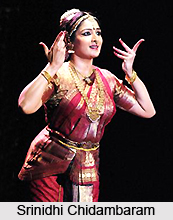 Srinidhi, at the tender age of three, started out dance training and from those days she made her mark in the domain of the Bharatnatyam.
Srinidhi, at the tender age of three, started out dance training and from those days she made her mark in the domain of the Bharatnatyam.
She holds the distinction of being the youngest artiste who has performed at the First Natya Kala Conference. Other landmark performances to her credit includes, performance at the Sangeet Natak Akademi`s Yuva Utsav held at Shimla, the Ghungroo Festival held at Bhopal, functioning at the Shanmukhananda Sabha at Bombay, performed at the De`jure Festival held at Pondicherry, the Chidambaram Natyanjali Festival, the Khajuraho Fetsival and at the inaugural function of the South Zone Cultural Center at Thiruvaiyaru. Under the supervision of renowned Guru Kalaimamani Sri Swamimalai S.K.Rajarathnam, Srinidhi Chidambaram was trained and she follows the Vazhuvoor style of Bharatnatyam.
When she was asked about her style she replied, "Basically it is my guru`s style. But over a period of time, you gradually have your individuality. I am not able to place it. My guru gave us a lot of creative freedom". Humble, talented and versatile Srinidhi Chidambaram restructured the art of Bharatnatyam with utmost sincerity.
With each and every performance staged by her received wide media acclamation and which ultimately lead to the several distinctions and awards to her. Thus Srinidhi Chidambaram became the most youthful recipient of the highest award of the state of Tamil Nadu (the home of Bharatnatyam) - the "Kalaimamani". Some of the others are: Nadanamamani from Karthik Fine Arts, Yuvakala Bharati, Dr.MGR Award from the Music Academy, Balasaraswati Memorial Award, Rotary Youth Merit Award, Best Child Talent in the International Year of the Child. Now a day, she has been chosen for the esteemed "Nrithyachoodamani" title given by the Krishna Gana Sabha.
Srinidhi, in the last few years, has come forth as a triumphant choreographer and has demonstrated various themes such as "Prabodhana", "Charitam", "Madhuram" and "Pudumai Penn". But her favorite item of dancing is Varnam. To her it gives plenteous scope for nritta and abhinaya. The dancing item named varnam brings out the potentiality of the dancer. A dancer who performs a varnam, one can be sure of the fact that he or she is experiencing the quality of the dancer. For her `the varnams of the Tanjore Quartette are replete with raga bhava and provide scope for proving one`s potential`. To her costumes plays an instrumental role in the dancing. As she said, "The costume should not be dazzling and distracting. I prefer simple elegant costumes. My mother helps me in this. My favourite costume is red and gold. Nothing to beat a Kanchipuram saree. In terms of jewellery the simpler the better. I like the taste of Malavika Sarukkai, Sudarani Ragupathi and Vyjayanthimala."
With a post graduation degree in Public Health and Preventive Medicine Srinidhi is medical degree holder.
Being a doctor Srinidhi Chidambaram has established Health First, an NGO to carry out `research in Public Health and to do service oriented programmes in Community health`. Basically it is a research and service organization, the member of which goes to schools and target teenager girls and educates them about reproductive health and makes them aware about HIV. They are also processing many other innovative plans in the near future for community.



















